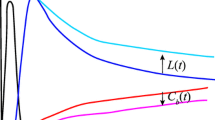Abstract
Quantitative methods for calculation of regional cerebral blood flow with technetium-99m hexamethylpropylene amine oxime (99mTc-HMPAO) have been proposed. These methods are very labour intensive and therefore are not useful in routine clinical practice. We describe a simple alternative method, using calibrated point sources as a scaling factor, whereby the tomographic slices are displayed as regional 99mTc-HMPAO brain uptake per cm3 brain tissue in 10−6 of the injected lipophilic dose. The method was validated on Jaszczak and Hoffman phantoms using a three-detector system with HR parallel and HR fan-beam collimators. Under the optimal conditions described in this paper, the measured to real activity ratio was 1.00 (SD = 0.06). The reproducibility of the cerebellar uptake in a group of ten normal volunteers and five patients was studied. Intra-individually a mean deviation of 12.6% was observed for the total group. For those persons with a heart rate difference of less than 5 units between the two studies, a mean deviation of 7.2% was obtained. Quantitative 99mTc-HMPAO brain uptake images can be useful for longitudinal studies, especially for follow-up, activation and pharmacological studies.
Similar content being viewed by others
References
Sharp PF, Smith FW, Gemmell HG, et al. Technetium-99m HM-PAO stereoisomers as potential agents for imaging regional cerebral blood flow: human volunteer studies. J Nucl Med 1986;27:171–177.
Costa DC, Ell PJ, Cullum ID, Jarritt PH. The in vivo distribution of 99TcmHM-PAO in normal man. Nuel Med Commun 1986:7:647–658.
Nowotnik DP, Canning LR, Cumming SA, et al. Development of a Tc-99m-labelled radiopharmaceutical for cerebral blood flow imaging. Nucl Med Commun 1985; 6:499–506.
Matsuda H, Oba H, Seki H, et al. Determination of flow and rate constants in a kinetic model of 99mTc-hexamethyl-propy-lene amine oxime in the human brain. J Cereb Blood Flow Metab 1988;8:61–68.
Nickel O, Nägele-Wöhrle B, Ulrich P, et al. rCBF-quantification with 99mTc-HMPAO-SPECT: theory and first results. Eur J Nucl Med 1989;15:1–8.
Pupi A, De Cristofaro M, Bacciottini L et al. An analysis of the arterial input curve for technetium-99m-HMPAO: quantification of rCBF using single-photon emission computed tomography. J Nuel Med 1991;32:1501–1506.
Murase K, Tanada S, Fujita H, et al. Kinetic behavior of technetium-99m-HMPAO in the human brain and quantification of cerebral blood flow using dynamic SPECT. J Nuel Med 1992:33:135–143.
Matsuda H, Tsuji S, Shuke N, et al. A quantitative approach to technetium-99m hexamethylpropylene amine oxime. Eur J Nucl Med 1992;19:195–200.
Szabo Z, Monsein LH, Maruki et al. Quantitative imaging of CBF with Tc-99m HMPAO [abstract]. Eur J Nucl Med 1991:18:667.
Nakamura K, Tukatani Y, Kubo A, et al. The behavior of 99Tc-hexamethyl propyleneamineoxime (99mTc-HMPAO) in blood and brain. Eur J Nuel Med 1989;15:100–107.
Hoffman EJ, Cutler PD, Digby WM, Mazziotta JC. 3-D phantom to simulate cerebral blood flow and metabolic images for PET. IEEE Trans Nucl Sci 1990; 37:616–620.
Hung JC, Corlija M, Volkert WA, Holmes RA. Kinetic analysis of technetium-99m d,I-HM-PAO decomposition in aqueous media. J Nuel Med 1988;29:1568–1576.
Galt JR, Grant SF, Alazraki NP. Effect of system resolution on quantitative measurements of the cerebral cortex and cerebellum and Spect brain images [abstract]. J Nucl Med 1991;32:728.
Dobbeleir A, Dierckx R, Vandevivere J. High spatial resolution Spect using a three-head rotating gamma camera and super fine lead fan-beam collimators [abstract]. Eur J Nucl Med 1991;18:600.
Kojima A, Matsumoto M, Takahashi M, et al. Effect of spatial resolution on Spect quantification values. J Nucl Med 1989;30:508–514.
Szabo Z, Seki C, Rhine J, et al. Effect of spatial resolution on absolute quantification with high resolution Spect [abstract]. Eur J Nucl Med 1991;18:604.
Kim HJ, Zeeberg B, Fahey F, et al. Three-dimensional Spect simulations of a complex three-dimensional mathematical brain model and measurements of the three-dimensional physical brain phantom. J Nucl Med 1991; 32:1923–1930.
18.Syed G, Eagger S, Toone B, et al. Quantification of regional cerebral blood flow (rCBF) using 99TcmHM-PAO and SPECT: choice of the reference region. Nucl Med Commun 1992;13:811–816.
19.Podreka I, Goldenberg G, Baumgartner C, et al. HMPAO brain uptake in young normal subjects: gender differences and hemispheric asymmetries. J Cereb Blood Flow Metab 1989;9 Suppl 1:202.
Lassen N, Andersen A, Friberg L, Paulson O, The retention of 99Tcm-d,I-HM-PAO in the human brain after intracarotid bolus injection: a kinetic analysis. J Cereb Blood Flow Metab 1988;8 (Suppl):S13-S22.
Author information
Authors and Affiliations
Additional information
Correspondence to: A. Dobbeleir
Rights and permissions
About this article
Cite this article
Dobbeleir, A., Dierckx, R. Quantification of technetium-99m hexamethylpropylene amine oxime brain uptake in routine clinical practice using calibrated point sources as an external standard: phantom and human studies. Eur J Nucl Med 20, 684–689 (1993). https://doi.org/10.1007/BF00181759
Received:
Revised:
Issue Date:
DOI: https://doi.org/10.1007/BF00181759




